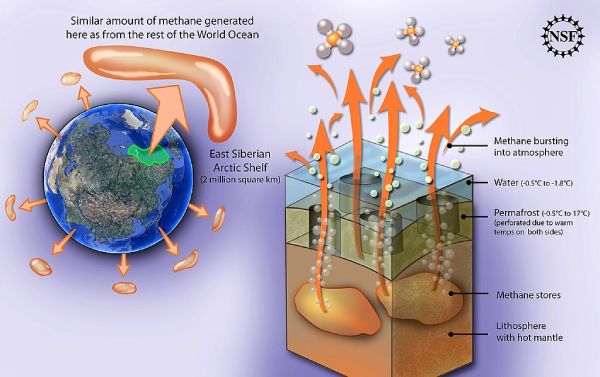The permafrost of the East Siberian Arctic Shelf (an area of about 2 million kilometers squared) is more porous than previously thought. The ocean on top of it and the heat from the mantle below it warm it and make it perforated like Swiss cheese. This allows methane gas stored under it under pressure to burst into the atmosphere. The amount leaking from this locale is comparable to all the methane from the rest of the world's oceans put together. Methane is a greenhouse gas more than 30 times more potent than carbon dioxide. -- National Science Foundation.
The bold black line at the top of the image below, adapted from Climate Reanalyzer, shows extremely high sea surface temperatures up to September 13, 2023, much higher than in any previous year on record.
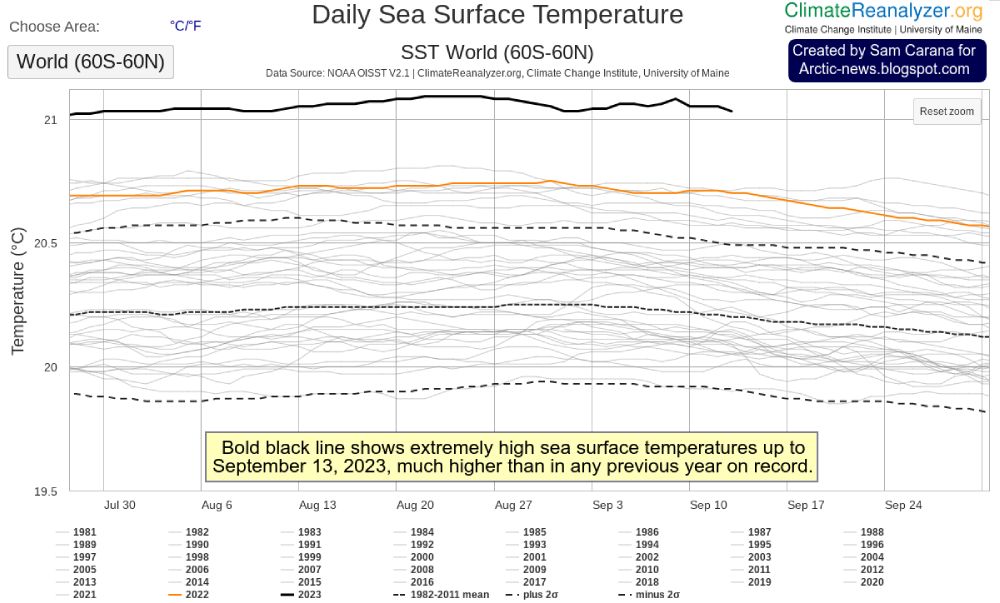
The image below, created with NASA data, shows why these extremely high sea surface temperatures are so worrying. The image shows monthly mean global surface temperature anomalies (open ocean) vs 1901-1930. The ochre trend, based on January 1900-August 2023 data, indicates the latent heat tipping point was crossed in 2021 and the seafloor methane tipping point could be crossed in 2033. The red trend, based on August 2008-August 2023 data and better reflecting variables such as El Niño, indicates that the seafloor methane tipping point could be crossed late 2023. Data show the seafloor methane tipping point was reached in August 2023.
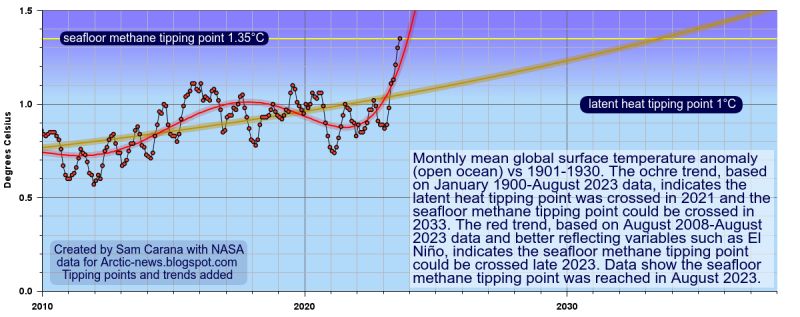
The latent heat tipping point is estimated to correspond with a sea surface temperature anomaly of 1°C above the long term average, 1901-1930 on the above image, as discussed in earlier posts such as this one.
Sea ice constitutes a latent heat buffer, consuming incoming heat as it melts. While the ice is melting, all energy (at 334 J/g) goes into changing ice into water and the temperature remains at 0°C (273.15K or 32 °F). Once all ice has turned into water, all subsequent energy goes into heating up the water, and will do so at 4.18 J/g for every 1°C the temperature of the water rises.
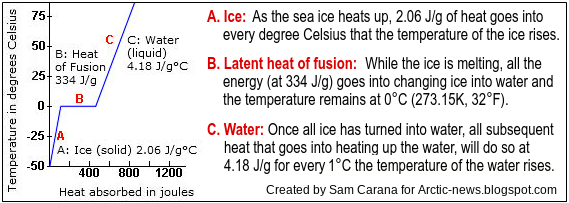
[ The Latent Heat Buffer ]
Once Arctic sea ice has become very thin, ocean heat that was previously consumed by melting the sea ice, no longer gets consumed by melting of the sea ice, and further incoming heat instead gets absorbed by the Arctic Ocean, rapidly pushing up the temperature of the water of the Arctic Ocean.
The latent heat tipping point has meanwhile been crossed. Loss of this buffer is linked to the seafloor methane tipping point, i.e. the point where additional heat reaches the seafloor and destabilizes hydrates contained in sediments at the seafloor. This tipping point comes with multiple self-reinforcing feedback loops, such as explosive growth in methane volume setting off further destabilization, rapid rise of Arctic temperatures, loss of permafrost and loss of albedo, and release of further greenhouse gases.
Crossing of the seafloor methane tipping point will occur later than crossing of the latent heat tipping point, i.e. the seafloor methane tipping point corresponds with a higher ocean temperature anomaly, estimated to correspond with a sea surface temperature anomaly of 1.35°C above the long term average.
The current situation is particularly precarious in the Arctic, as the North Atlantic Ocean is very hot and the Gulf Stream keeps pushing hot water toward the Arctic Ocean, while Arctic sea ice has become very thin and the latent heat tipping point has been crossed.
As the temperature of the Arctic Ocean keeps rising, more heat can reach sediments located at the seafloor, since much of the Arctic Ocean is very shallow and sediments at the seafloor of the Arctic Ocean can contain vast amounts of methane.
The danger is that additional heat will destabilize hydrates in these sediments, leading to explosive eruptions of methane, as its volume increases 160 to 180-fold when leaving the hydrates, and resulting in huge eruptions of methane both from the destabilizing hydrates and from methane that is present in the form of free gas underneath the hydrates.
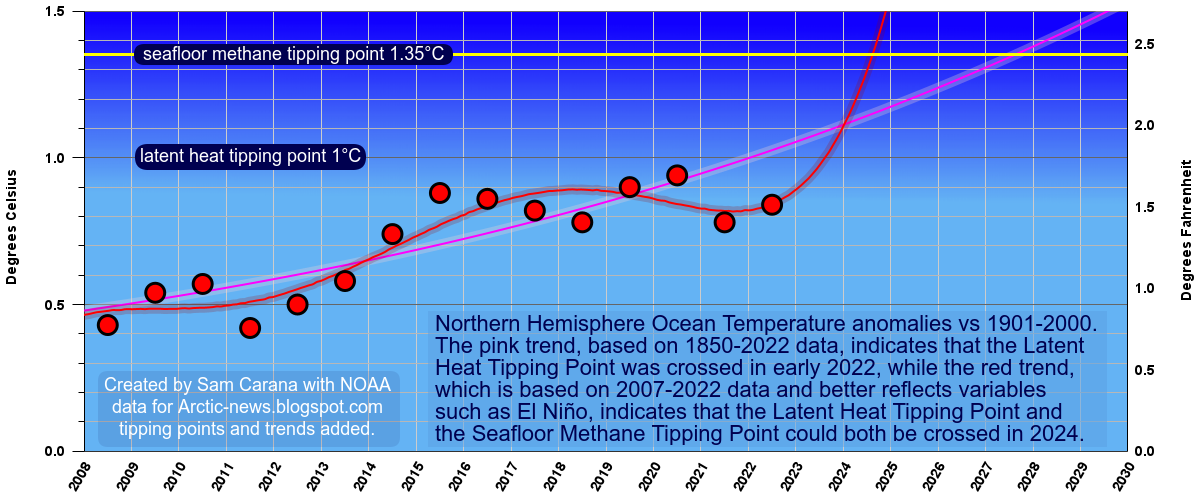
[ from earlier post ]
The above image, from an earlier post, illustrates that warnings have been given before about the danger of these two tipping points getting crossed in the Arctic. In the above image, the trends are based on annual sea surface temperature data for the Northern Hemisphere. The seafloor methane tipping point is estimated to correspond with ocean temperature anomalies reaching 1.35°C above the long term average.
The image below further illustrates the high sea surface temperatures in and around the Arctic Ocean, with the red to yellow colors indicating temperature anomalies above the 1981-2011 average, and the green circle marking a sea surface temperature anomaly near the North Pole of 0.4°C on September 13, 2023.
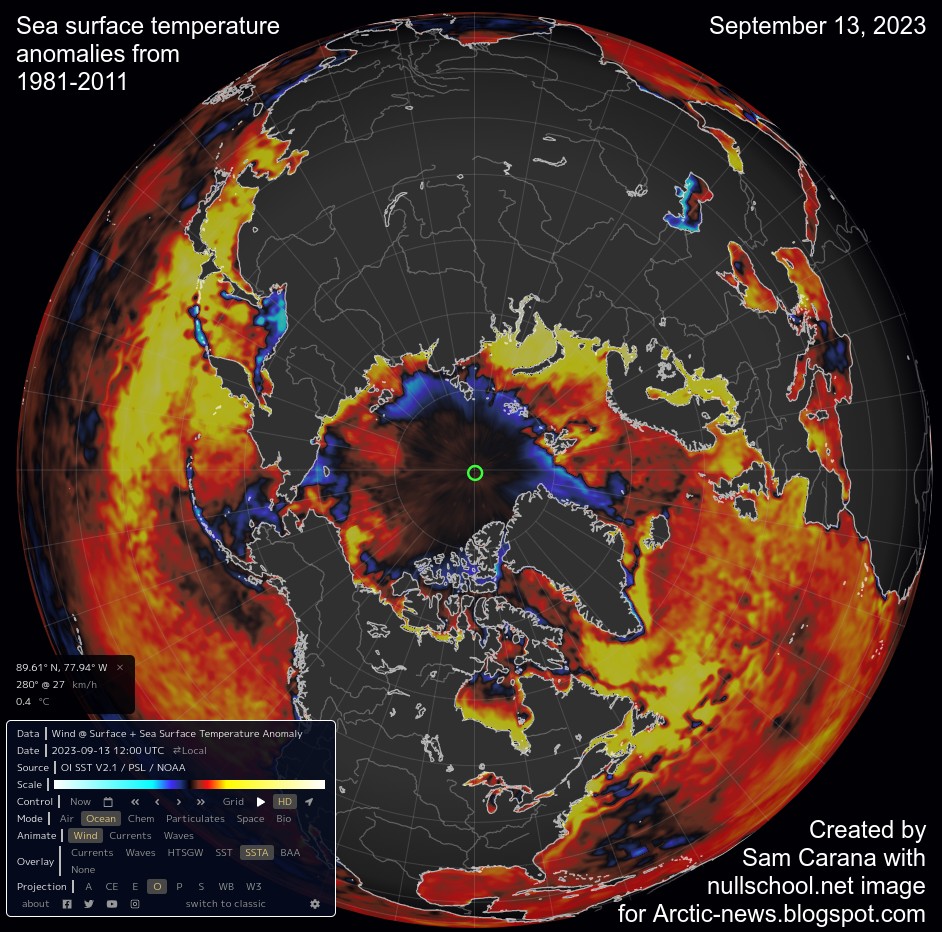
The image below illustrates how incoming ocean heat that previously was consumed in the process of melting of the sea ice, is now causing the water of the Arctic Ocean to heat up, with more heat reaching the seafloor of the Arctic Ocean, which has seas that in many places are very shallow.

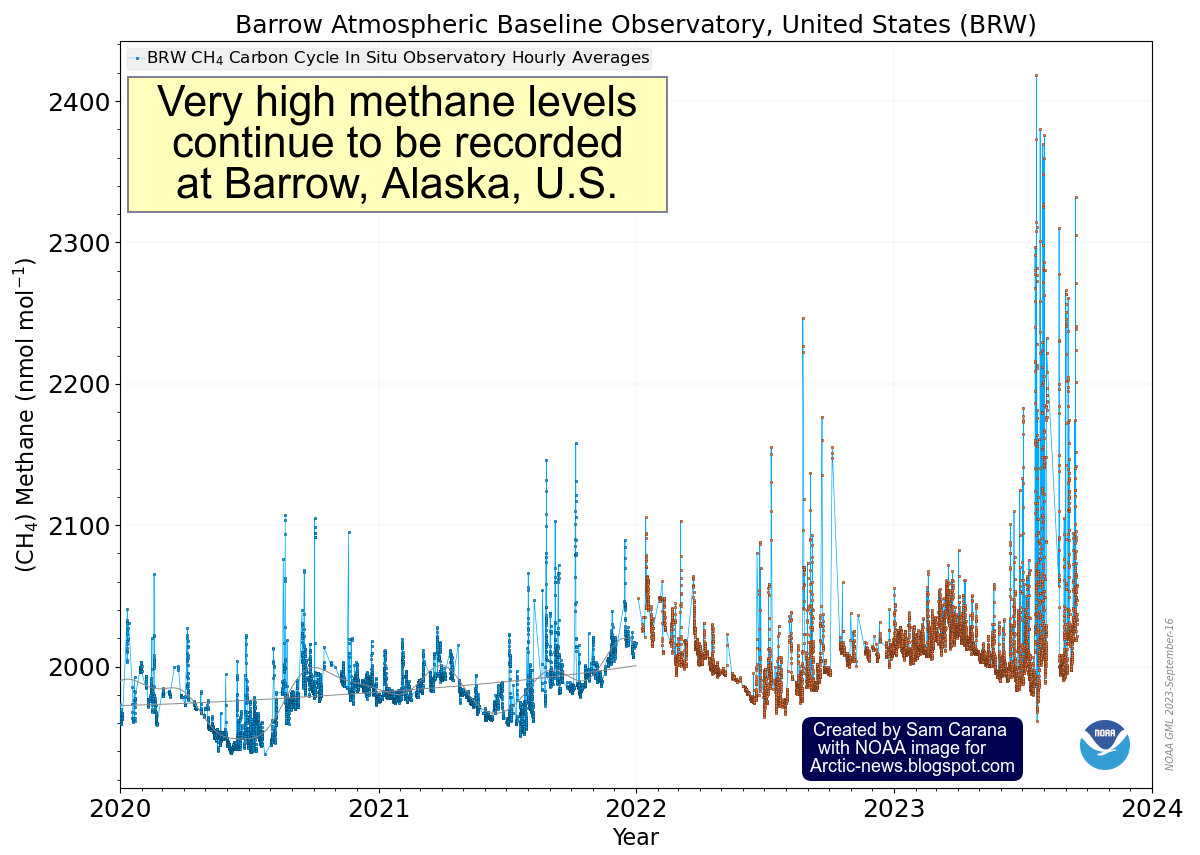
Ominously, very high methane levels continue to be recorded at Barrow, Alaska, as illustrated by the above NOAA image.
The MetOp satellite image below shows methane levels, with the magenta color indicating the highest methane levels recorded at surface level (1000 mb), on September 15, 2023 am.
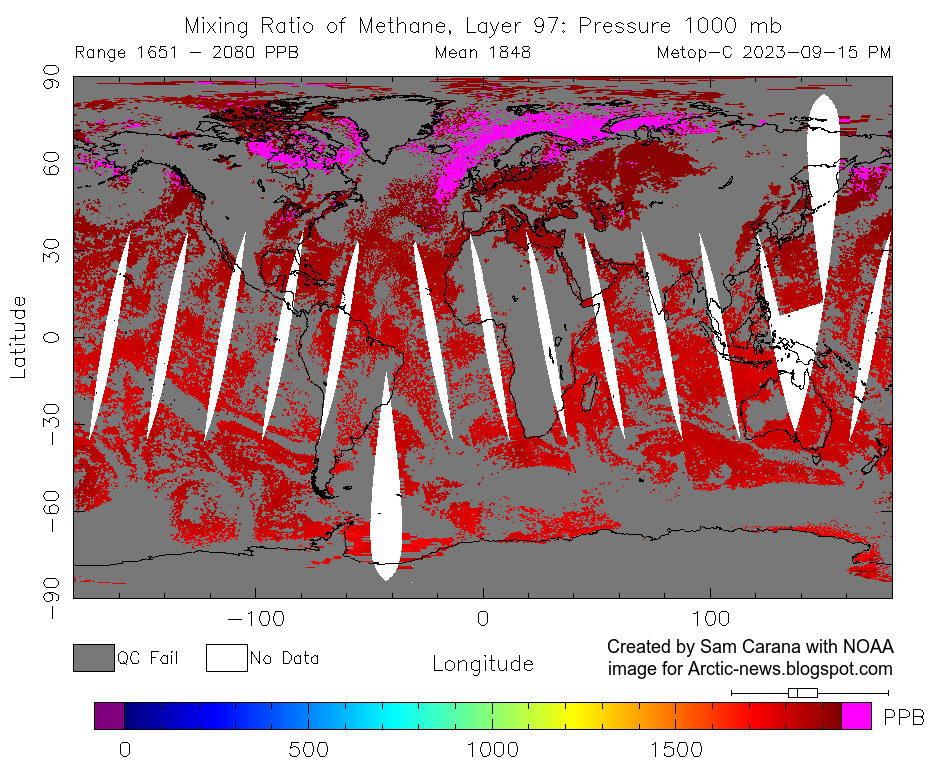
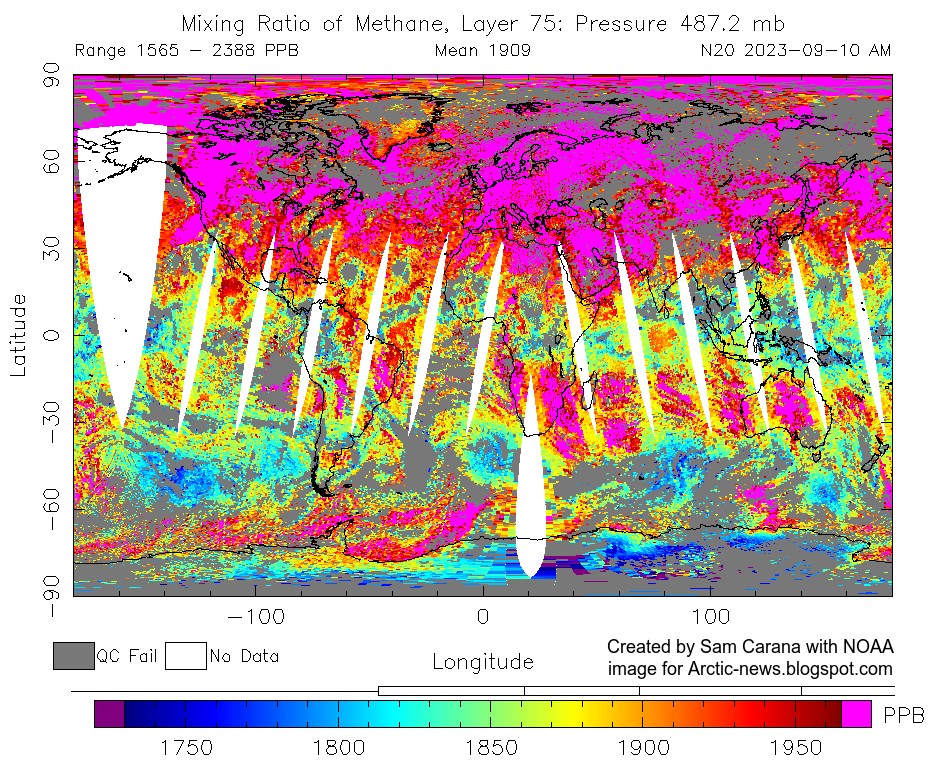
Note the high levels over the Beaufort Sea and elsewhere over the Arctic Ocean, as well as high levels recorded over oceans in the Southern Hemisphere.
Climate Emergency Declaration
A catastrophe of unimaginable proportions is unfolding. Life is disappearing from Earth and runaway heating could destroy all life on Earth. At 5°C heating, most life on Earth will have disappeared. When looking only at near-term human extinction, 3°C will likely suffice.
The situation is dire and is getting more dire every day, which calls for a Climate Emergency Declaration and implementation of comprehensive and effective action, as described in the Climate Plan with an update at Transforming Society.
Links
https://climatereanalyzer.org/clim/sst_daily
https://data.giss.nasa.gov/gistemp/graphs_v4/customize.html
NOAA - Barrow Atmospheric Baseline Observatory, United States
https://gml.noaa.gov/dv/iadv/graph.php?code=BRW&program=ccgg&type=ts
NOAA - MetOp satellite records
https://www.ospo.noaa.gov/Products/atmosphere/soundings/heap/iasi/iasiproducts.html
NOAA - N20 satellite records
https://www.ospo.noaa.gov/Products/atmosphere/soundings/nucaps/NUCAPS_composite.html
Two Tipping Points
https://arctic-news.blogspot.com/2023/08/two-tipping-points.html
Sea surface temperature at record high
https://arctic-news.blogspot.com/2023/03/sea-surface-temperature-at-record-high.html
https://arctic-news.blogspot.com/2023/07/record-high-north-atlantic-sea-surface-temperature.html
Albedo, latent heat, insolation and more
https://arctic-news.blogspot.com/p/albedo.html
Latent Heat
https://arctic-news.blogspot.com/p/latent-heat.html
The Threat of Global Warming causing Near-Term Human Extinction
https://arctic-news.blogspot.com/p/threat.html
FAQ
https://arctic-news.blogspot.com/p/faq.html
Feedbacks
https://arctic-news.blogspot.com/p/feedbacks.html
https://arctic-news.blogspot.com/p/climateplan.html
https://arctic-news.blogspot.com/2022/10/transforming-society.html
https://arctic-news.blogspot.com/p/climate-emergency-declaration.html

